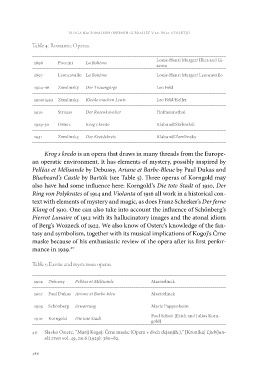Page 388 - Weiss, Jernej, ur. 2019. Vloga nacionalnih opernih gledališč v 20. in 21. stoletju - The Role of National Opera Houses in the 20th and 21st Centuries. Koper/Ljubljana: Založba Univerze na Primorskem in Festival Ljubljana. Studia musicologica Labacensia, 3
P. 388
vloga nacionalnih opernih gledališč v 20. in 21. stoletju
Table 4: Romantic Operas.
1896 Puccini La Bohème Louis-Henri Murger/ Illica and Gi-
acosa
1897 Leoncavallo La Bohème Louis-Henri Murger/ Leoncavallo
Leo Feld
1904-06 Zemlinsky Der Traumgörge Leo Feld/Keller
Hofmannsthal
1909/1922 Zemlinsky Kleide machen Leute Klabund/Skrbinšek
Klabund/Zemlinsky
1910 Strauss Der Rosenkavalier
1929-30 Osterc Krog s kredo
1931 Zemlinsky Der Kreidekreis
Krog s kredo is an opera that draws in many threads from the Europe-
an operatic environment. It has elements of mystery, possibly inspired by
Pelléas et Mélisande by Debussy, Ariane et Barbe-Bleue by Paul Dukas and
Bluebeard’s Castle by Bartók (see Table 5). Three operas of Korngold may
also have had some influence here: Korngold’s Die tote Stadt of 1910, Der
Ring von Polykrates of 1914 and Violanta of 1916 all work in a historical con-
text with elements of mystery and magic, as does Franz Schreker’s Der ferne
Klang of 1910. One can also take into account the influence of Schönberg’s
Pierrot Lunaire of 1912 with its hallucinatory images and the atonal idiom
of Berg’s Wozzeck of 1922. We also know of Osterc’s knowledge of the fan-
tasy and symbolism, together with its musical implications of Kogoj’s Črne
maske because of his enthusiastic review of the opera after its first perfor-
mance in 1929.40
Table 5: Exotic and mysterious operas.
1902 Debussy Pelléas et Mélisande Maeterlinck
1907 Paul Dukas Ariane et Barbe-bleu Maeterlinck
1909 Schönberg Erwartung Marie Pappenheim
1910 Korngold Die tote Stadt Paul Schott [Erich and Julius Korn-
gold]
40 Slavko Osterc, “Marij Kogoj: Črne maske (Opera v dveh dejanjih.),” [Kronika] Ljubljan-
ski zvon vol. 49, no.6 (1929): 380–82.
386
Table 4: Romantic Operas.
1896 Puccini La Bohème Louis-Henri Murger/ Illica and Gi-
acosa
1897 Leoncavallo La Bohème Louis-Henri Murger/ Leoncavallo
Leo Feld
1904-06 Zemlinsky Der Traumgörge Leo Feld/Keller
Hofmannsthal
1909/1922 Zemlinsky Kleide machen Leute Klabund/Skrbinšek
Klabund/Zemlinsky
1910 Strauss Der Rosenkavalier
1929-30 Osterc Krog s kredo
1931 Zemlinsky Der Kreidekreis
Krog s kredo is an opera that draws in many threads from the Europe-
an operatic environment. It has elements of mystery, possibly inspired by
Pelléas et Mélisande by Debussy, Ariane et Barbe-Bleue by Paul Dukas and
Bluebeard’s Castle by Bartók (see Table 5). Three operas of Korngold may
also have had some influence here: Korngold’s Die tote Stadt of 1910, Der
Ring von Polykrates of 1914 and Violanta of 1916 all work in a historical con-
text with elements of mystery and magic, as does Franz Schreker’s Der ferne
Klang of 1910. One can also take into account the influence of Schönberg’s
Pierrot Lunaire of 1912 with its hallucinatory images and the atonal idiom
of Berg’s Wozzeck of 1922. We also know of Osterc’s knowledge of the fan-
tasy and symbolism, together with its musical implications of Kogoj’s Črne
maske because of his enthusiastic review of the opera after its first perfor-
mance in 1929.40
Table 5: Exotic and mysterious operas.
1902 Debussy Pelléas et Mélisande Maeterlinck
1907 Paul Dukas Ariane et Barbe-bleu Maeterlinck
1909 Schönberg Erwartung Marie Pappenheim
1910 Korngold Die tote Stadt Paul Schott [Erich and Julius Korn-
gold]
40 Slavko Osterc, “Marij Kogoj: Črne maske (Opera v dveh dejanjih.),” [Kronika] Ljubljan-
ski zvon vol. 49, no.6 (1929): 380–82.
386


